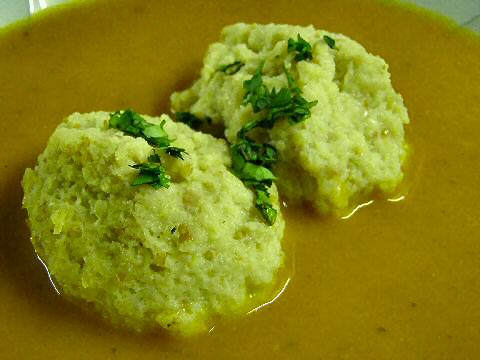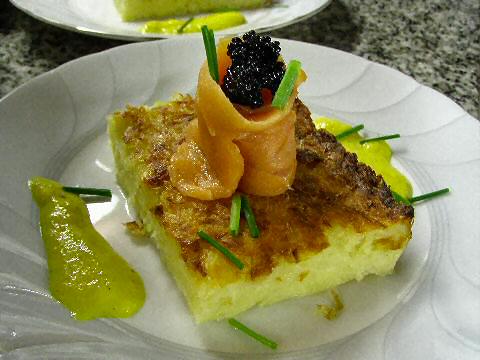“The reason for serving latkes on Hanukkah is to commemorate the miracle of the oil, in which a tiny bit of pure olive oil needed to kindle the Eternal Light in the Holy Temple in Jerusalem lasted for eight days. No potatoes were involved in the extraordinary event, of course, because potatoes come from the New World and were nowhere to be found in the land of Israel more than 2,000 years ago. But somehow, potatoes became universally accepted as part of the culinary traditions of Hanukkah.”
– Faye Levy, Detroit News
Buenos Aires – I am surprised, no… shocked, appalled, scandalized… that I haven’t been flooded with e-mails asking “Nu… how did the Chanukah Christmas Eve dinner go?” I guess everyone got it out of their system beforehand asking “How are you gonna pull that one off and keep everyone happy?” Look, we all know (even those who don’t want to admit it) that early Catholicism co-opted already existing festivals to make them more palatable to whomever they were in the midst of converting. And we Jewish folk will eat pretty much anything if it’s put in front of us, and second helpings please – oh sure, it’s not like grandma used to make, but it’ll do in a pinch. Or for dinner.
It went well. Quite well I think. One guest just sent me a note saying,“And thanks again for a spectacular dinner on Christmas eve – I didn’t miss home a bit.” – I’ve already advised him not to mention the latter part to his mother.
It was definitely a bit of a mishmosh, with dishes coming in from various culinary traditions, though in the end, I think it all worked together. We started off the evening with a semi-almost traditional Mexican Ensalada de Noche Buena, or Christmas Eve Salad. It’s a colorful mix of fruits and a little vegetable, all dressed in mayonnaise, topped with toasted peanuts… sort of the Mexican version of an Ambrosia Salad. But… there’s no jicama here, which would have been a nice touch… I suppose I could have used water chestnuts or something similar. And I forgot to put the peanuts on the dish (I did spend the next day or two nibbling on them). And pomegranates are not currently in season, so I had to use pomegranate syrup. These are the things that derivatives are made of. The salad was a composed arrangement of cooked beet wedges, slices of fresh pineapple, orange supremes, diced apples, and sliced bananas atop lettuce leaves, and then a dollop of a homemade mayo that was perked up and turned pink by the addition of the pomegranate syrup and then thinned out with a little cream. We went with a level up of wines as well for the evening, to make it a little more special. For this dish we started off with a festive Chandon Rosé Brut.

Tossup for me on the soup or the next course as to favorites… I suppose it shouldn’t be a surprise, these two drew a good amount of their inspiration from my own background. Yet, I managed to throw in some twists from other cultures. I had to get in the “seven fishes” from southern Italian tradition – don’t ask why, I just did, and it fit perfectly with making gefilte fish, which are not a Chanukah dish – though many folk eat them year round, they’re often associated with Passover and made with matzoh meal. The seven fish thing also fit with various Jewish superstitions as well – gefilte fish are supposed to be made from more than one fish in order to avoid the appearance of borer, or “choosing” on a Sabbath (it was a Wednesday, so that didn’t really apply), and top that with fish are supposedly not subject to ayin hara, the “evil eye”, and eating a mix of fish therefore brings good luck. But we also had to get in a touch of Henry’s Peruvian background…
The gefilte fish were made following the same recipe I’ve presented before, though with a mix of roughly equal parts of lenguado, merluza, mero, pez gallo, salmón blanco, brótola, and abadejo (sole, hake, bass, elephant fish, perch, cod and pollack), and rocoto peppers instead of jalapeños. They were served chilled in a likewise chilled tomato and cilantro broth – I cooked red onions and a couple of red hot peppers in a little olive oil until soft, added garlic, cumin, and a mix of sweet and hot paprika, then lots of diced, fresh plum tomatoes, some tomato paste, a whole lot of cilantro, and some salt. I covered that with water, brought it to a simmer and let it cook until the tomatoes were nice and soft. Then pureed the whole thing in the blender and chilled it. To finish, I seasoned it with salt, pepper and lime juice (after it was chilled). The soup was paired with Las Perdices Sauvignon Blanc 2007, easily one of last year’s best Sauvignons from Argentina, and only 500 cases made.

Okay, I know all the arguments that say you have to stand there and individually fry latkes, or just a couple at a time, and they have to be round, and really crunchy on the outside, and greasy, and all that. But, remember, this was simply inspiration time. I baked them as one giant latke-ish sheet in a large pan, finishing them by broiling them to get the top nice and browned. Basically – grated potatoes and onions, extra liquid squeezed out, mixed with a little whole wheat flour and eggs, spread in a well oiled pan and then topped with more oil. I cut it into squares and then topped each with a rollup of smoked salmon and some caviar, and then, originally I’d been thinking about huancaina sauce, the Peruvian yellow pepper and cheese sauce for potatoes, but it sounded too heavy, so went with just a nice fiery pepper sauce – roasted yellow bell peppers and ají amarillos pureed with green onions, garlic, white vinegar, olive oil, water, lemon juice, cumin, turmeric, salt and white pepper. I found a beautiful Alfredo Roca Bonarda Rosado 2007 that matched up really well with this dish.
For the main course I had been looking at roasting a goose – I finally found a source for them here. Problem is, that goose loses a huge amount of weight in melting fat when it’s cooked – a fifteen pound turkey might feed a dozen people, but a fifteen pound goose will at most feed about 6-7, and I don’t have the oven space to cook two at a time. I thought about whole ducks, I could have gone with a couple of those, but decided against having to randomly give one person the leg, another the breast… all that stuff that can be worked out when carving at the table with a turkey on t-day, but when plating in the kitchen, you know someone’s going to be disappointed. So, magrets of duck (plump breasts) – and I decided to make them the way I’ve done before, with smoked eggplant puree and a piquillo pepper sauce. I wanted a nice Syrah to go with the duck and found a couple of bottles of 2004 Gentile Collins Prestigio that worked quite nicely.
And finally, bringing in a Chanukah tradition of, more or less, a cheesecake, and a Christmas Eve plum pudding – I made a cheesecake that had a layer of fresh red plums that had been cooked in butter and brown sugar first. It didn’t quite firm up right – the day was hot and humid, there was a ton of stuff in the refrigerator, or maybe the plums were just to moist – but the flavors worked beautifully even if the texture was a bit too soft. A nice port-style wine, the Bruno Barra Tardía Tinto 2005 pulled off the finish perfectly.
[…] think about this last week being Chanukah when I was planning the menu. I could have brought back gefilte fish and latkes, or maybe the roast chicken with lemon sauce. But I didn’t. I did light my candles each night […]
[…] then smothered in a tomato, garlic and chili sauce, this time served over what is, essentially, a baked latke square, and for our vegetarian friends, the same treatment with halved portobello mushrooms (which turned […]
[…] always does, this time not coinciding with Christmas festivities (so we didn’t have to do a Jesus-Maccabee mashup again). That still didn’t mean I was going particularly traditional – though I have to […]